Manchester United have suffered a disappointing start to the season so far, with the worst start to a league campaign in 34 years. Seven games in, the Red Devils have earned 9 points and lost both opening games of the UEFA Champions League group stage to Bayern Munich and Galatasaray S.K..
Set plays have played a particularly crucial part in this poor start of the season, with United having conceded three goals from dead balls in the Premier League already, as well as giving away a penalty from a corner against Bayern, getting away with a potential penalty shout against Wolves and conceding a goal directly after an attacking corner against Nottingham Forest in the opening minutes of the game. From an attacking point of view, Man United have struggled to create many chances from set plays. However, the exceptional aerial ability of Casemiro and his intelligent movement inside the box has allowed United to remain somewhat efficient from the limited chances they manufacture.
In this tactical analysis, we will look into the tactics behind Manchester United’s attacking and defending corner setups, with an in-depth analysis of why the different forms have been ineffective so far. This set-piece analysis will examine why these setups have had some signs of potential, why these setups have been exposed, and how United can improve to become more solid defensively and more potent when attacking set plays.
Defending Set Plays
One of the most significant issues United have had when defending set plays has been down to their rigid setup, which doesn’t allow much room for adapting to different opposition attacking structures.
For most corners, Manchester United attempt to use three zonal defenders, staggered across the six-yard line, as well as a defender on each post, who starts as a zonal defender before retreating on the line as the cross is taken, if the ball doesn’t approach them. Three players are used as man markers, whilst the remaining two are used to collect balls during the second phase or to close down short corner routines. While the approach may seem defensively sound, the issue is the lack of ability to adapt to opposing teams who rotate between different ways.
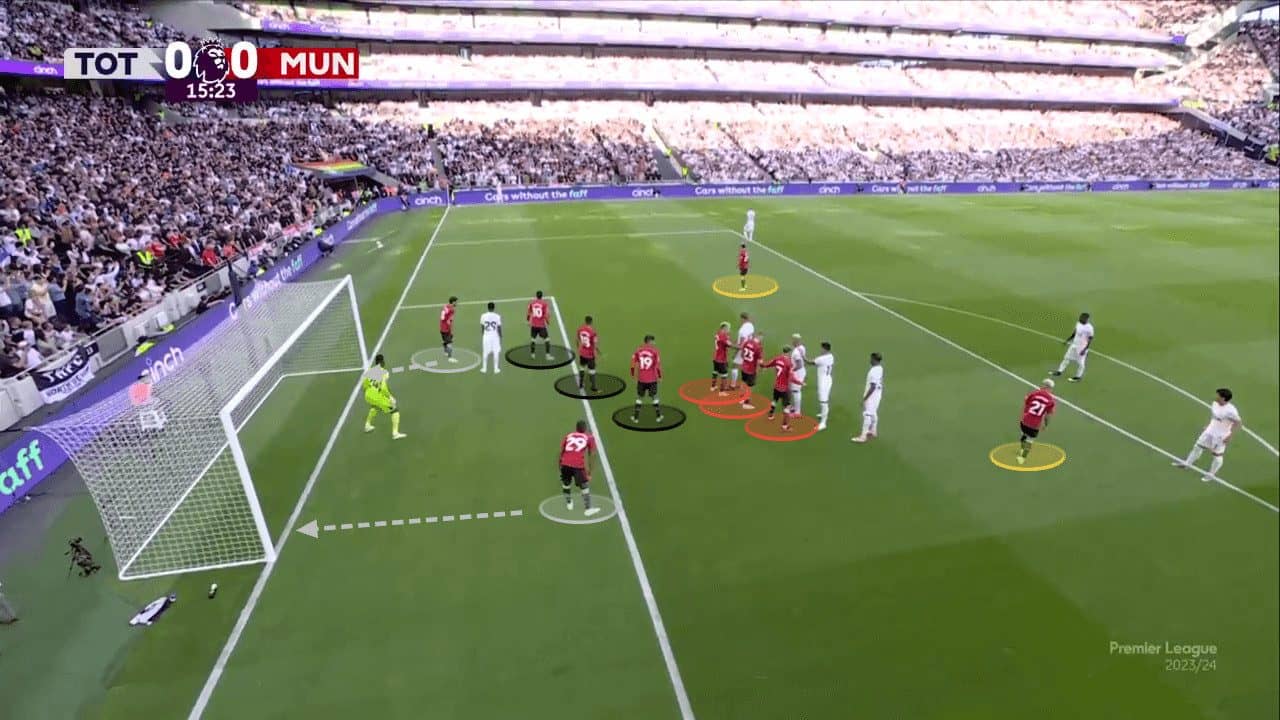
At times, it would be fair to say that United overcompensate when defending the near side of the six-yard box. With the player on the near post beginning as a zonal marker, Manchester United have been, at times, left in positions where three zonal defenders are stepping on each other’s toes to prevent opponents from gaining any access to the near side of the six-yard box. As we can see in the example below, the central of the three zonal defenders becomes nearly irrelevant, as both his neighbours have already got the entire area covered. This near-side overkill has often resulted in the Red Devils being undermanned in other areas of the penalty area.
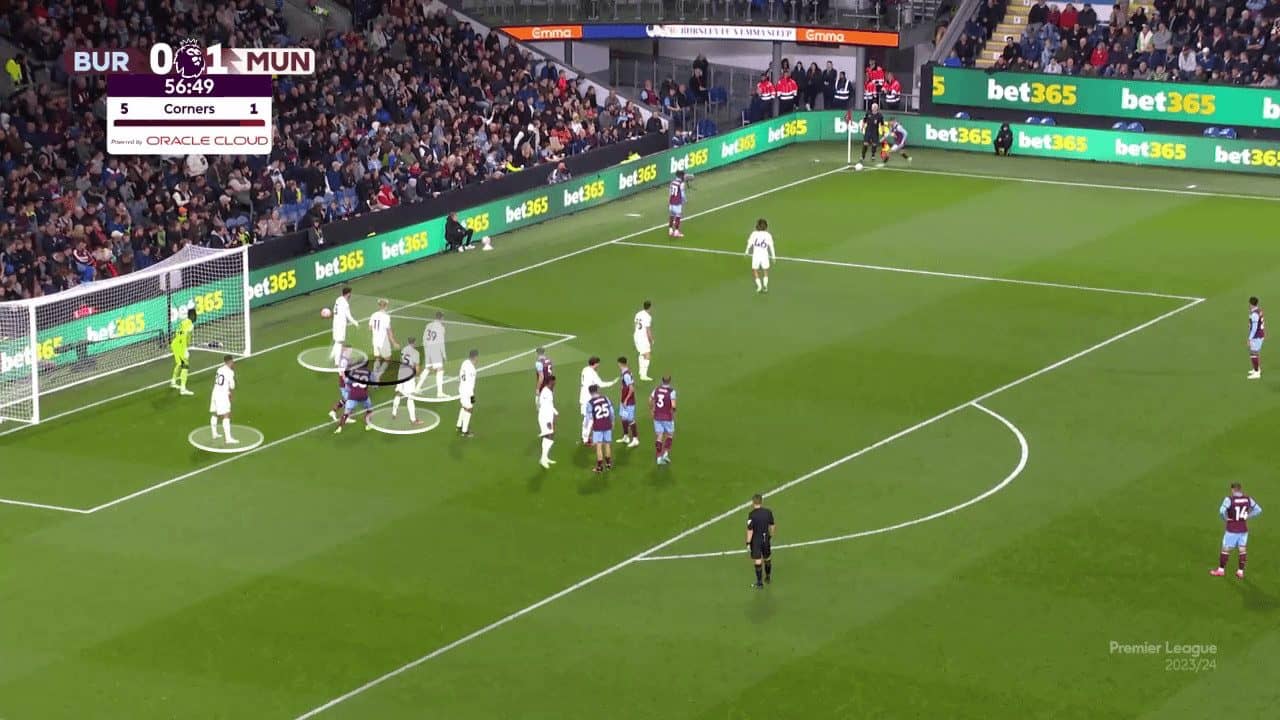
As mentioned above, the heavy, near-post zonal defending can cause other problems for Man United. With them being outnumbered around the penalty spot, one attacker has the ability to compete for the ball without disruption. Furthermore, the heavy zonal positioning, which focuses on the near side of the six-yard box, also leaves bigger spaces in the back half of the six-yard box. With one back post defender being occupied by an attacker, the nearest free player who can attempt to attack the ball can be seen in the middle of the six-yard line, looking directly at the ball (#35). Jonny Evans has his body positioned perpendicular to the goal, meaning that his back is facing the back post, and any ball aimed over the top of his head towards the back post will be tough for him to reach and attack optimally. This provides Burnley with the opportunity to allow one attacker to arrive at the back post and have the running advantage to help him win the aerial duel over a backtracking defender.
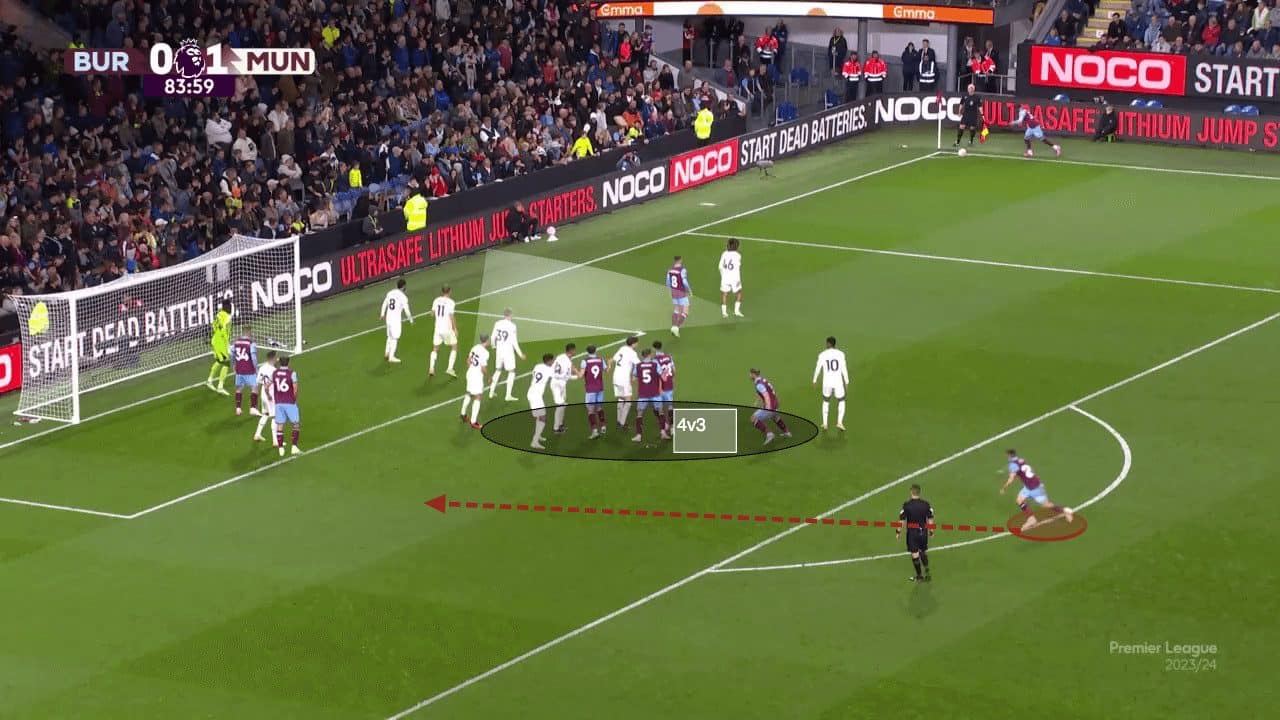
The most glaring issue of this zonal system is that it doesn’t consider the starting positions of the attacking side. As shown in the image below, United leaves around four zonal markers protecting the near post, whilst Arsenal’s attackers are waiting at the back of the six-yard box to attack the ball. Not marking every attacking option means that at least one attacker will have the opportunity to run towards the ball and time the jump and header for the aerial duel precisely at the right moment.
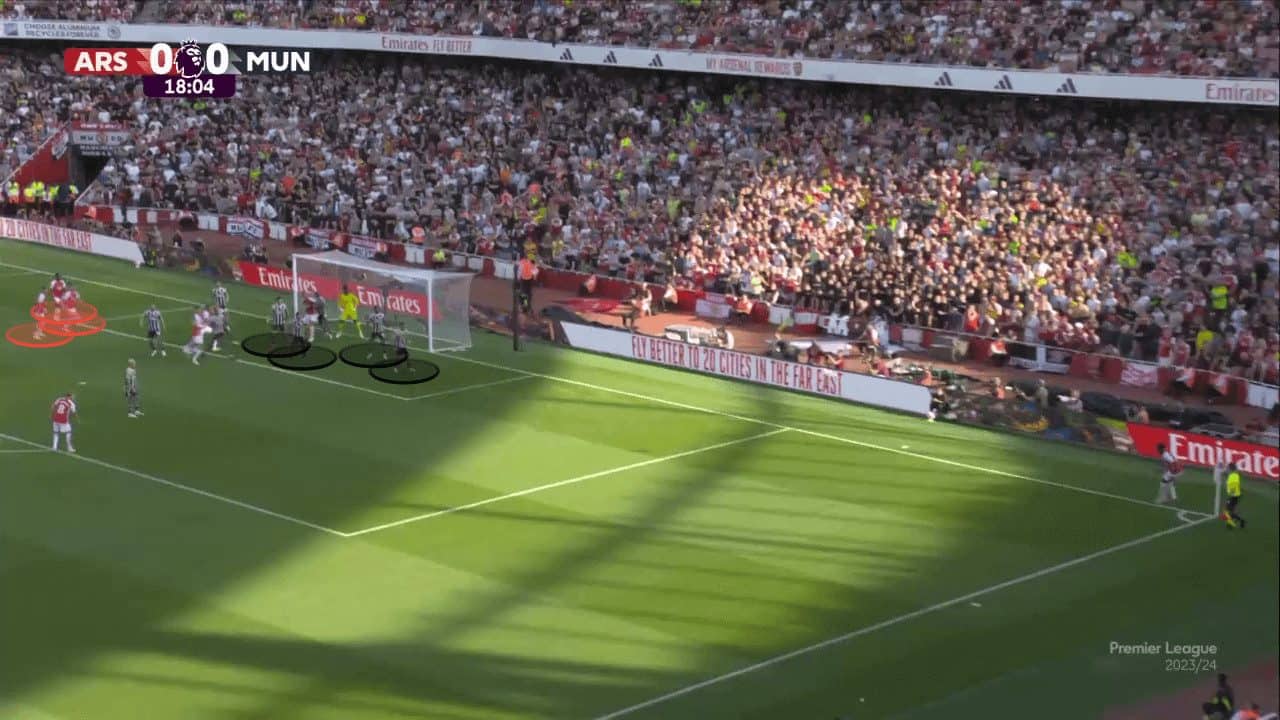
The obsession with protecting the near side of the six-yard box, or poor preparation, means that Manchester United try to ‘cheat’ by moving into the space early to protect it rather than reacting to the opposition setup, as mentioned before. As a result, the defenders are eager to arrive in those spaces first, which gives attackers additional time and space at the back post.
In addition, the outnumbering of defenders in these high-value areas means that decoy runs can be highly effective. The example below shows how a 5v3 situation turns into a 3v1, where two attackers have dragged two man markers away from the target area.
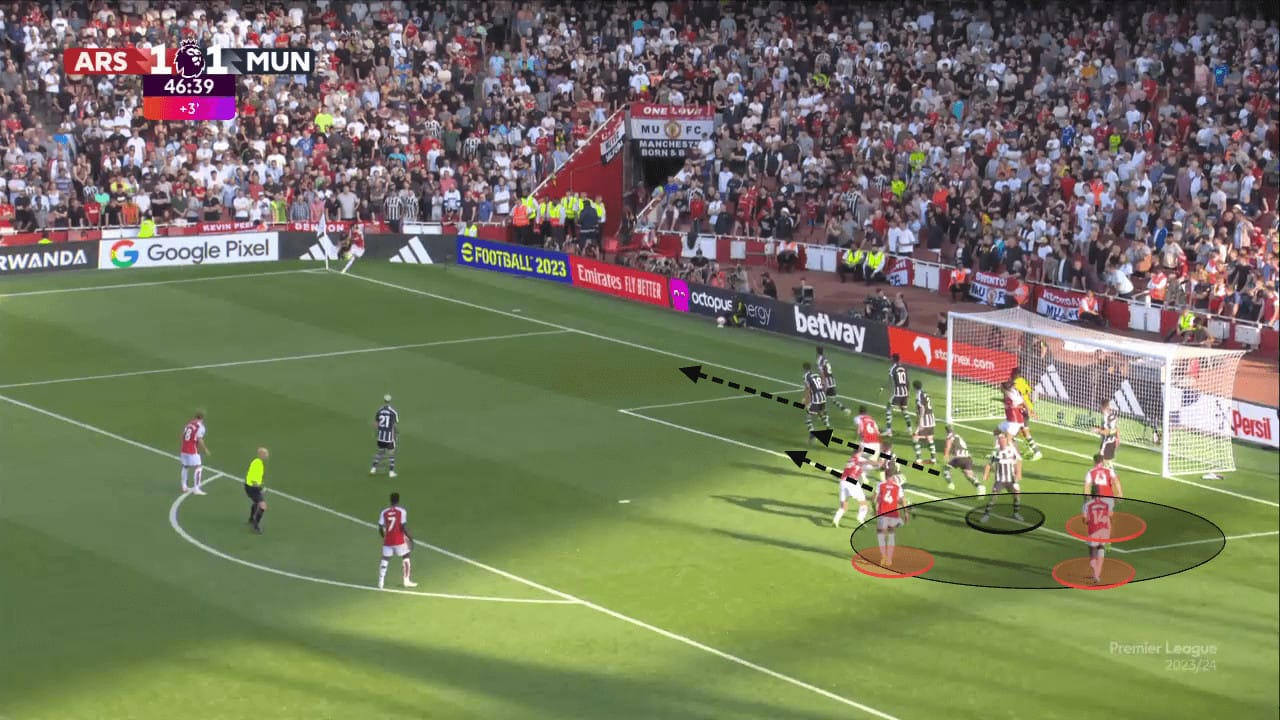
Once a team can get into this dangerous area with a numerical overload, creating space for a player becomes quite simple. The use of a screen, where one attacker would sacrifice himself to immobilize the last defender in that area, then allows for the spare player in that area to be able to receive the ball with lots of space and without any pressure, allowing them to make the best choice they can see.
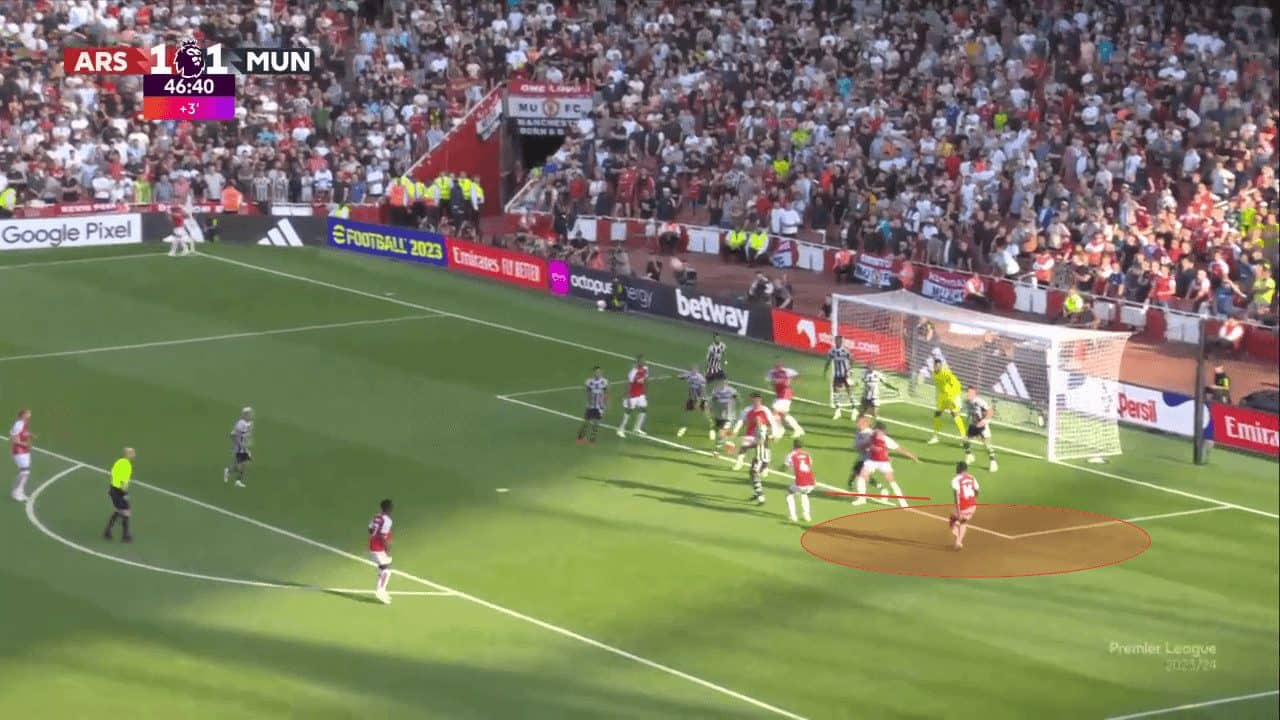
Another reason behind the ability of attacking teams to overload Man United’s defence is due to their positioning of two players on the goalposts. United aim to be as secure as possible by planting a defender on each post to protect against any headed efforts; however, their methods of dropping off away from attackers and giving them added time and space could cause problems. Protecting the posts may make the shot less likely to go in the back of the net. However, other teams can prevent more shots by being braver and using additional man markers rather than having players standing on the post. As we can see in the example below, the passive positioning of the defender means Declan Rice has all the time in the world to bring the ball down and volley it into the back of the net. Furthermore, the deeper position of every defender also results in Manchester United being slower to react to second balls, as many of their players become trapped inside their six-yard box.
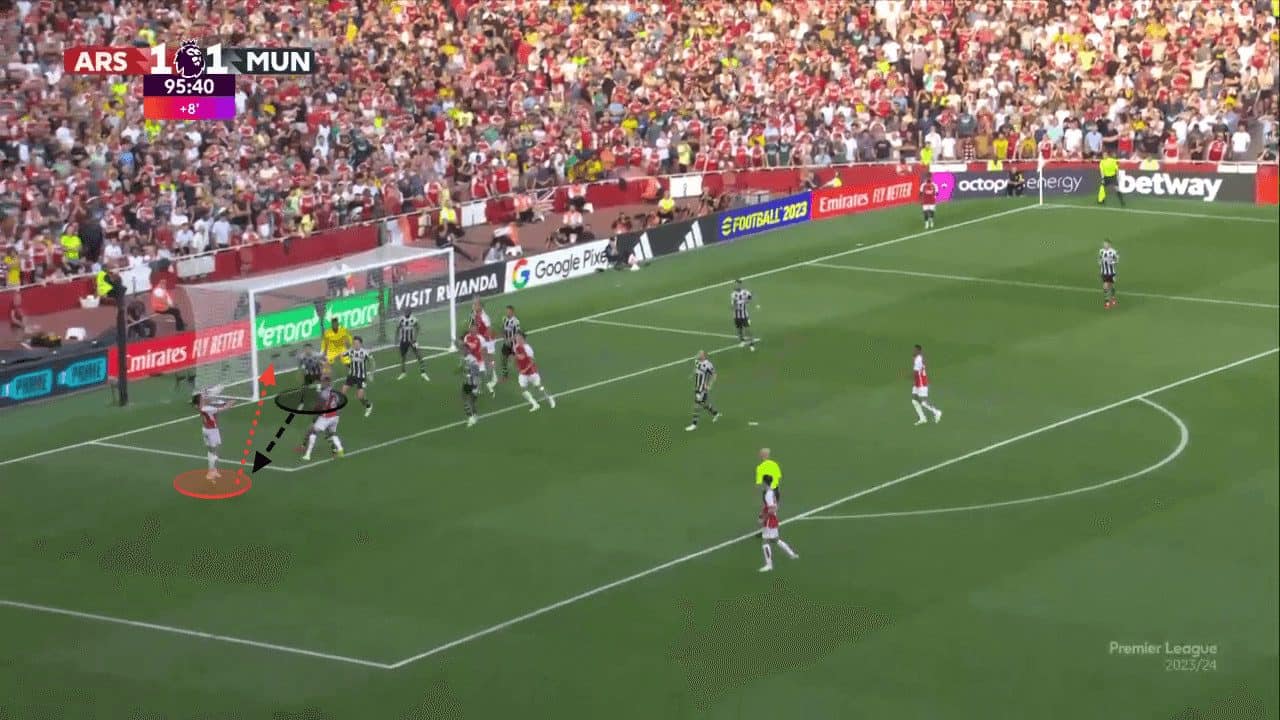
Similarly to corner kicks, the deep defending position of the Man United defenders has caused issues from wide free kicks. Manchester United have actually been fairly strong at defending free kicks from deeper positions, where attackers are unable to position themselves in an area where they can attack space unopposed. Without the running headstart for opponents, United’s defenders are strong in the 1v1 aerial duels and can handle these crosses, but in the positions where United are so deep, opponents are able to get the advantages and cause problems in aerial duels.
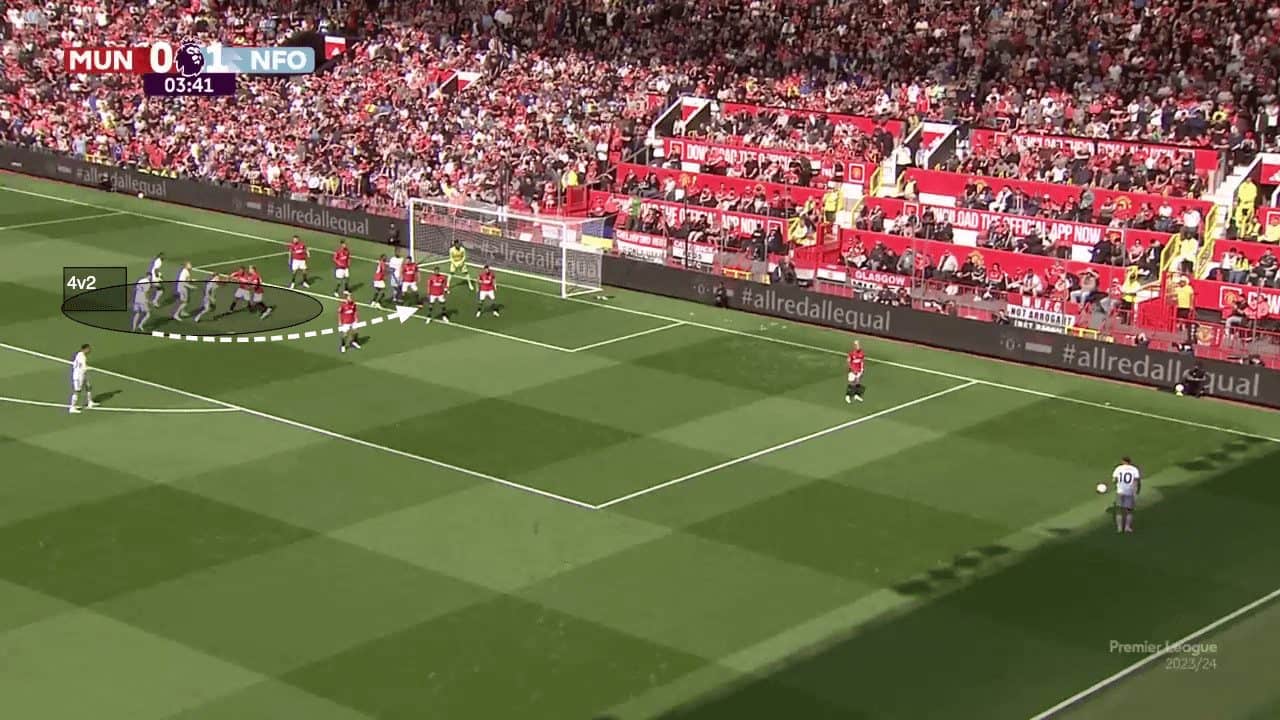
Attacking Set Plays
Manchester United have won more corner kicks this season than every other team in the league apart from Arsenal, yet they have still not managed to score a goal from such a situation in the league. However, after looking into these attacking structures, it is no surprise that they have been so underwhelming.
One of the things that stands out immediately about the Red Devils when watching their corners is their hesitance to attack the box and take risks. They have been very risk-averse in the season’s opening months, with them often using five players around the edge of the box to collect loose balls or play short corners and combinations whilst only leaving four players to attack the penalty area.
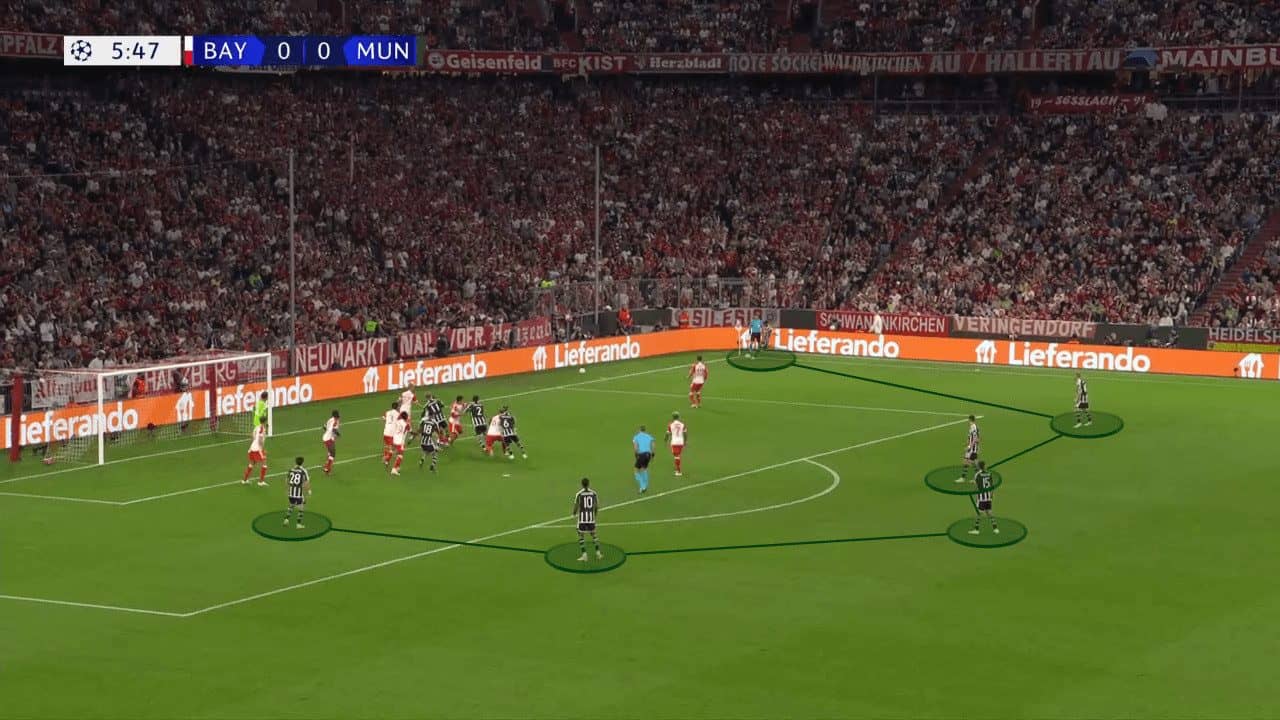
As you can see below, only four players have the intent to attack the ball, with five players spread out across the width of the penalty area outside the box. Out of the four players, one will always attempt to attack the back post for any flick-ons or rebounds, leaving only three attackers to try to win the aerial duel. This leaves Manchester United at a massive disadvantage compared to other sides, as many teams will use five or six players to attack the ball rather than three. Teams need to have attackers make unselfish movements and decisions in order to create space for a target player, but with only three attackers, there are only two possibilities to create space for the target player.
Having so few players attacking the ball makes it easier for defending sides to man mark the few attackers and have zonal defenders to cover the remaining spaces available. Even if a potential screen or decoy run creates space, there are zonal defenders anticipating the cross. With so few options available, these zonal markers can step out to attack the ball even if an attacker has immobilized a man marker or zonal defender.
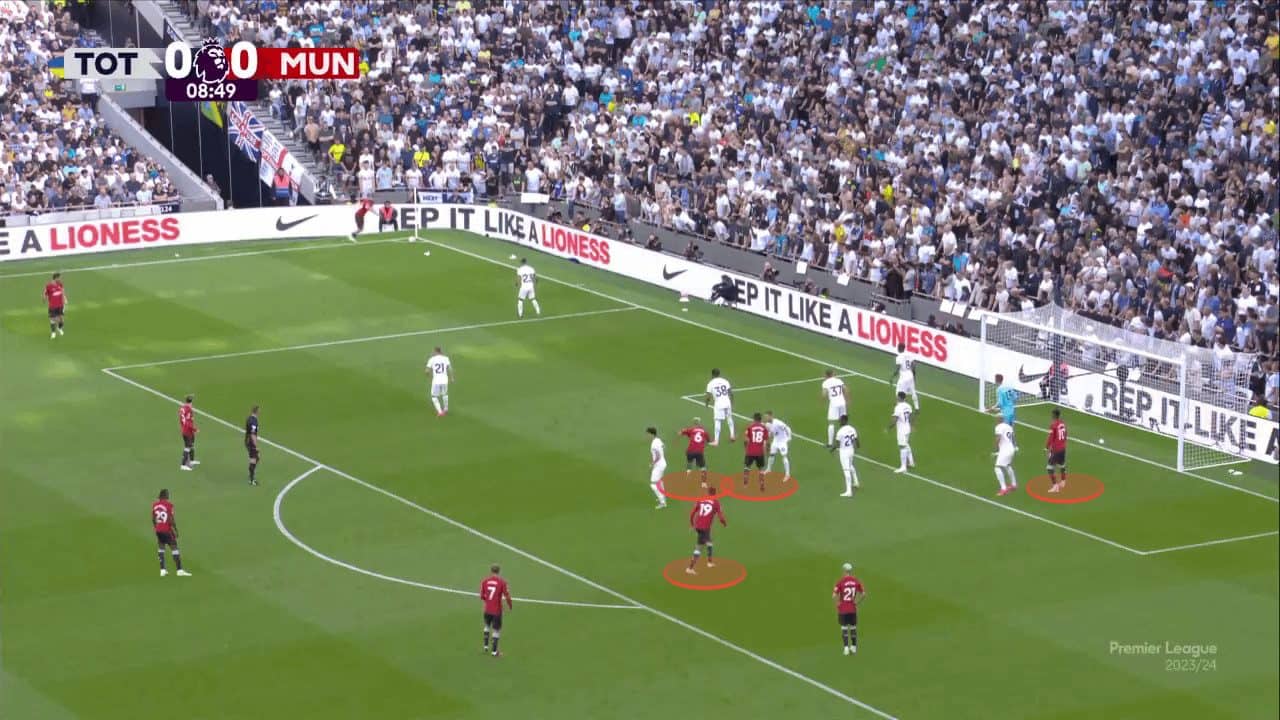
Another issue of attacking the box with so few players is that Manchester United become more susceptible to being counterattacked. Although there is a significant presence of red shirts outside the box, the image below shows the area inside the box where you could expect rebounds to land, with opposition defenders being closer to winning that second ball and relieving the pressure.

Another problem with Manchester United’s structure from corners is their profile of players who lurk outside the box. The three most central players outside the box are Rashford, Wan-Bissaka/Dalot, Antony, or anyone in his spot. Rashford provides the threat with shots from a distance, whilst the opposite-sided winger provides a creative threat by keeping the attack alive by delivering it back into the box. A more defensive option is in the middle to balance the side. However, the issue with the players surrounding the box is that the players lack the defensive awareness and anticipation to kill any potential counters. Using two attackers outside the box leaves Manchester United vulnerable to conceding chances from counterattacks, with the players less likely to react quickly or win the duels for the ball when competing with attackers who run with the ball at them. They may have the speed to keep up, but lacking the know-how can leave them highly vulnerable in these situations.
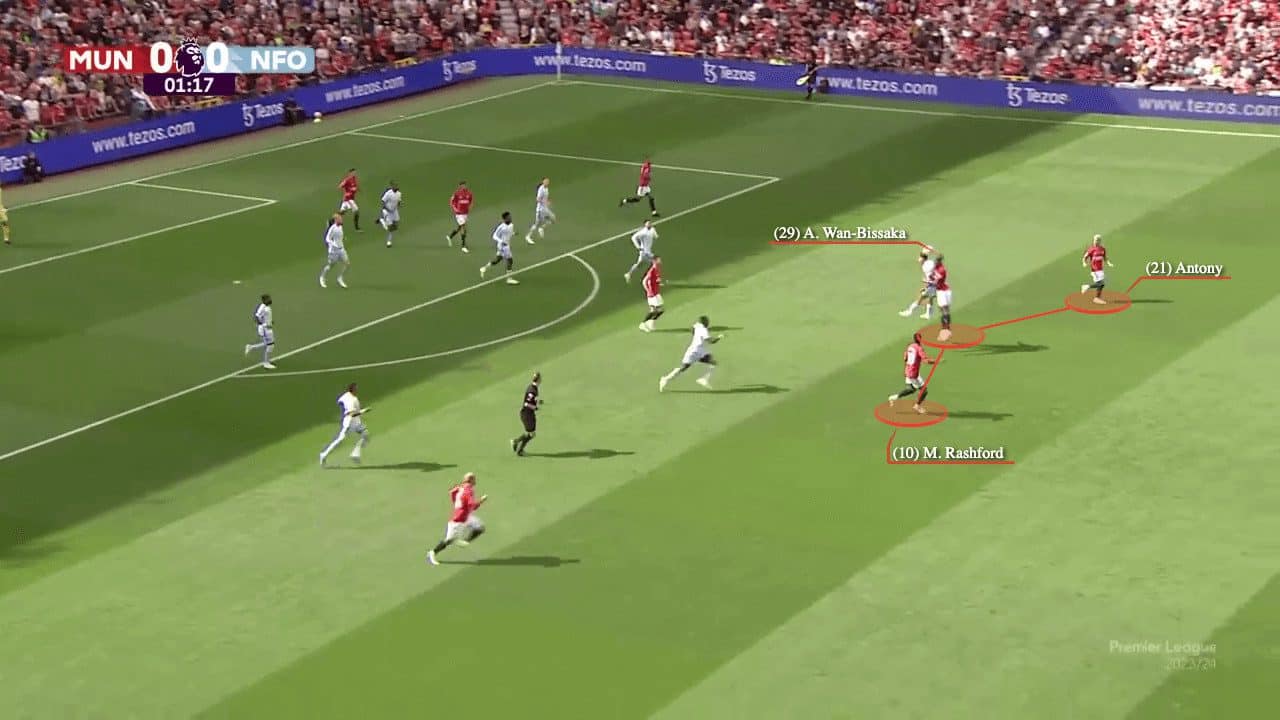
Something that has started to change recently with Hojlund’s introduction is the lack of obstruction on the keeper. In the opening weeks, many corners were easily intercepted by the opposition goalkeeper, who had the ability to come out and claim the ball. However, Rasmus Hojlund seems to have taken matters into his own hands by taking on the responsibility to sacrifice himself and block the keeper from coming off his line to provide his teammates with more opportunities to win aerial duels. I believe United could reassign the role to a weaker aerial threat, as the number of strong aerial players they have is small, and Hojlund should be on the end of the crosses rather than aiding others.

One apparent issue with United’s set plays has been the lack of coordination and choreography in their moves. As shown in the image below, each player makes a different run, while the corner is crossed into an area where no United player has attacked. These corner routines clarify that they haven’t been practised enough on the training ground, where no player knows the intent behind the corner and is trying to make things happen by themselves. Even with the two central players, Lindelof has occupied his marker, leaving Martinez open to attack the ball, but he is unaware and unable to take the initiative to gamble and attack the space.
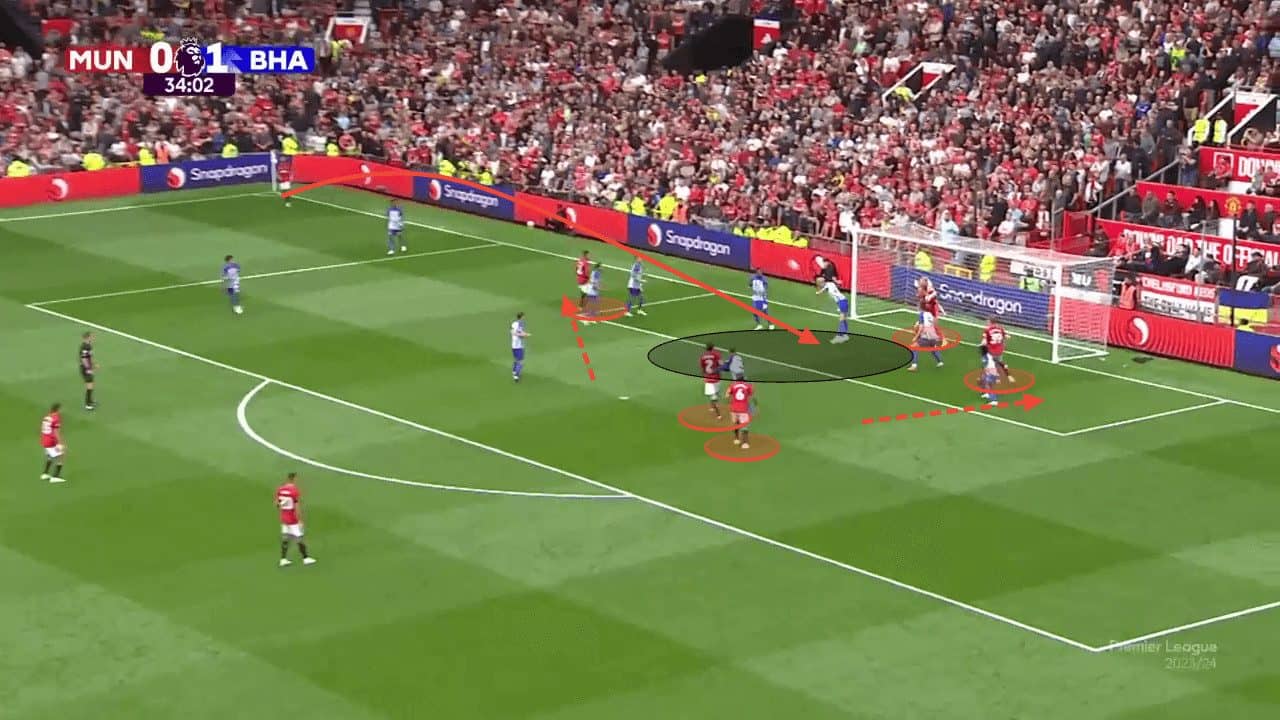
In one of the most recent fixtures against Burnley, Manchester United showed significant improvement in their corner kicks by implementing a variety of screens decoy runs, increasing the number of players attacking the box, and altering the starting positions to start by the goalkeeper. All these components of an effective corner kick have been nonexistent in the earlier games of the season. Still, this routine has shown that Manchester United have the ability and potential to improve their efficiency from corners.
In the example below, Hojlund is preventing the goalkeeper from claiming the cross, whilst Scott McTominay uses a screen to create space for Jonny Evans to compete in the aerial duel 1v1 with his marker. Although Evans still has competition for the aerial duel, the fact that it is in a high-value area, within six yards from the goal, means that Evans does not need to generate power on the header but only make the first contact and redirect the ball into the back of the net. Lindelof also makes a decoy run away from the target area to give Evans more space to compete for the ball.
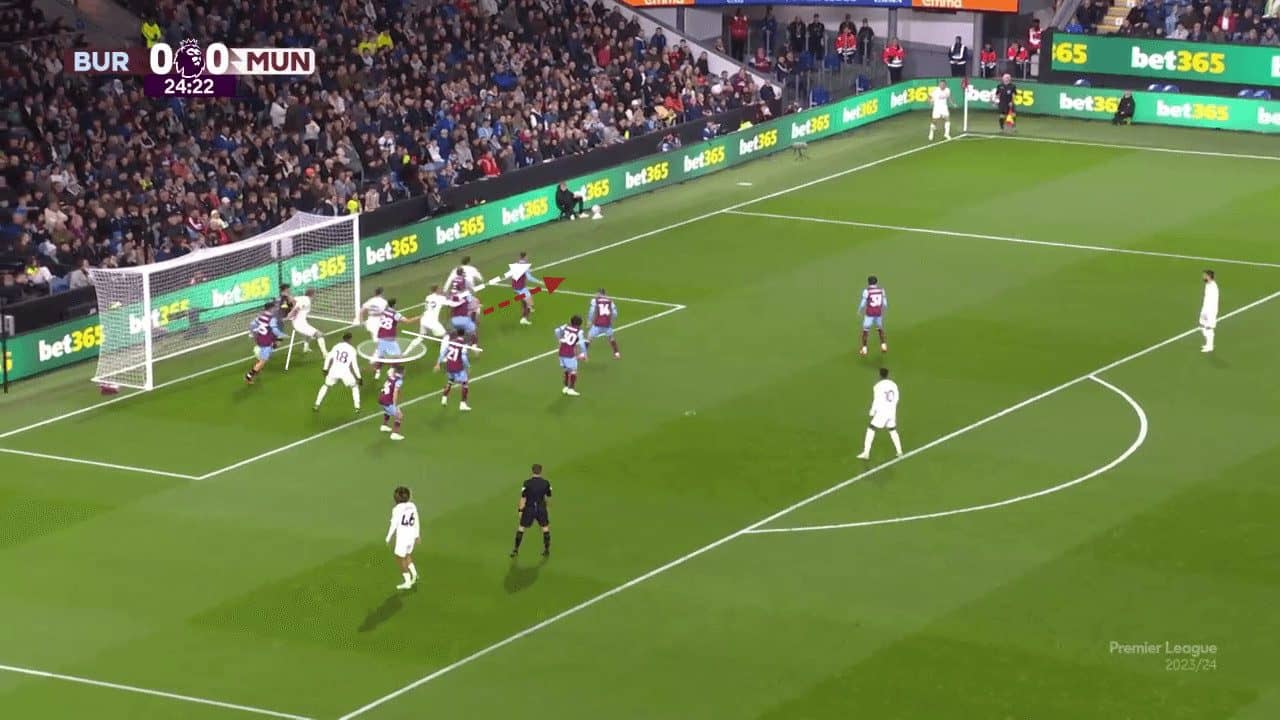
There have also been glimpses of creativity from wide free kicks, with a more trendy routine appearing across many leagues. With teams focusing on protecting one part of the box more than others, teams can use extra passes to distract defenders before exploiting the open spaces. For example, we can see the free kick being taken from the right wing below. The defensive unit is tilted towards the left-hand side of the box. To increase the space available on that right side, the ball is switched to the left-hand side, where United know the ball will be pressured.
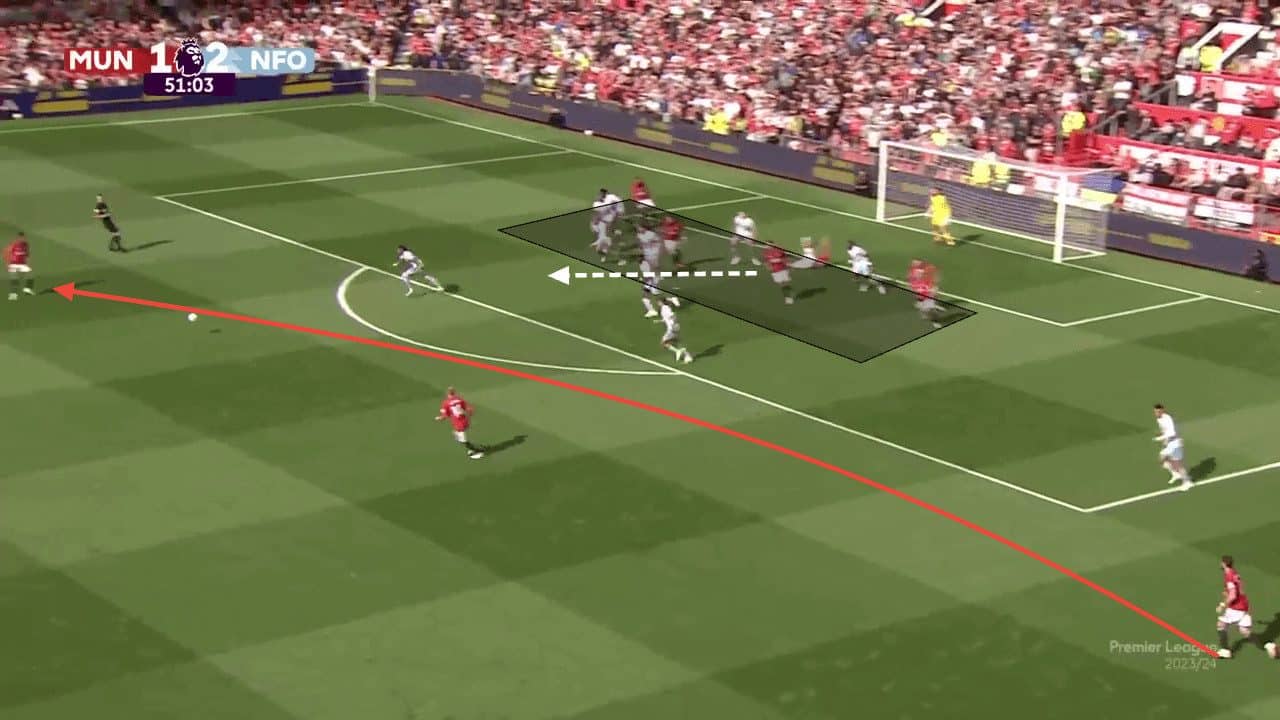
Once the defenders pressure the ball on the left side, they turn their backs to the right side of the box, where Bruno Fernandes is able to ghost into the ample space available and receive a lofted pass in lots of space, creating a clear-cut goalscoring chance all thanks to a switch of play.
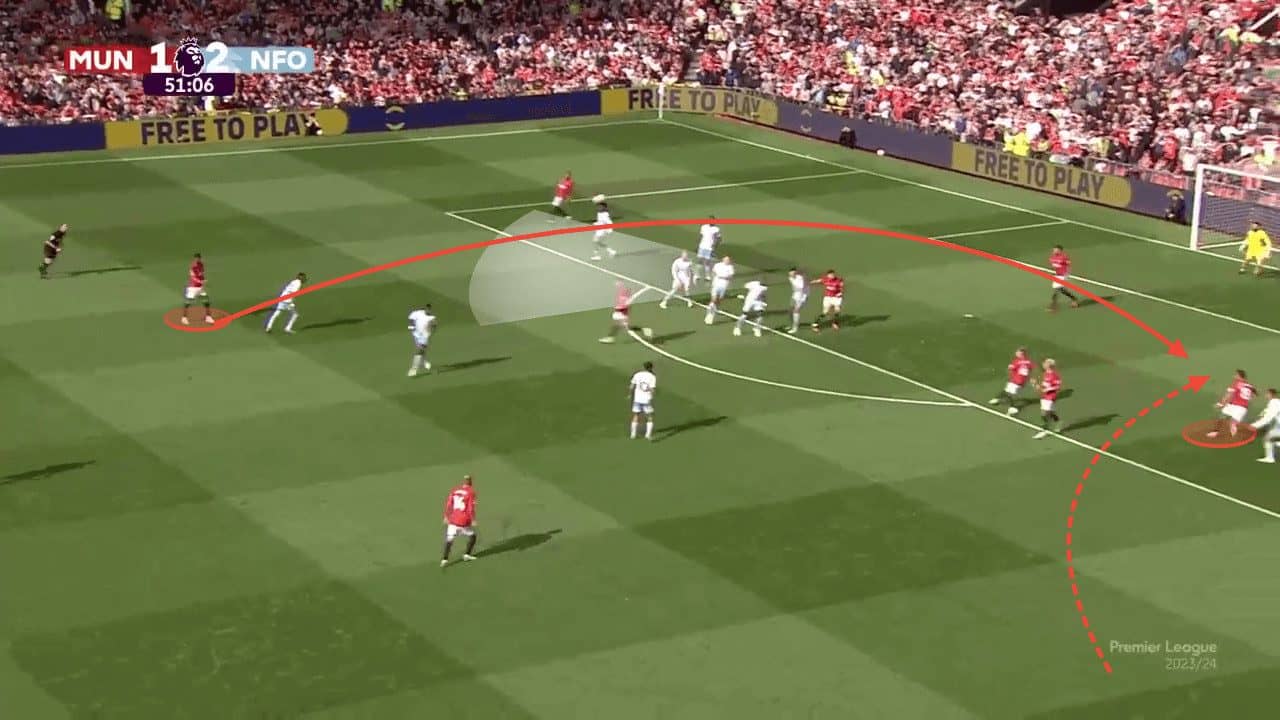
Summary
This tactical analysis has detailed the numerous ways in which Manchester United have struggled to both defend and attack set play. However, they have shown signs of potential to improve in both aspects but must become more fluid to adapt from game to game to make the most of these opportunities.
Defensively, Manchester United need to be adaptable to avoid opponents gaining numerical superiority in the penalty area and, at the least, show a reaction after a team has exposed a gap in their defensive setup. Like in the Arsenal game, United need to be able to admit their weaknesses at the back post and alter their setup to prevent the opposition from creating any additional chances rather than being stubborn and sticking with the same setup.
In the attacking phase, Manchester United should look to carry on with their routines in the recent Burnley fixture but must continue to work on coordinating their attacks, with each player having a clear role to follow. Too many set plays have seemed like each attacker is out to get a goal for themselves. In contrast, certain players must make unselfish movements to create more space for the likes of Casemiro or Hojlund, who can be trusted to put the ball into the back of the net. This will only be possible if United take more risks by increasing the number of attackers who enter the box.
There have been many teams who have used set plays to make up for their poorer team performances in the past, and shifting focus to become incredibly efficient from set plays could provide Erik Ten Hag with the time he needs to keep earning points whilst slowly working on the team performances as a whole.






Comments